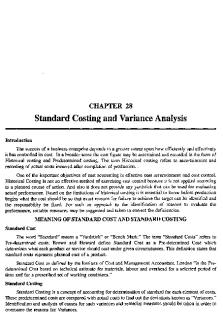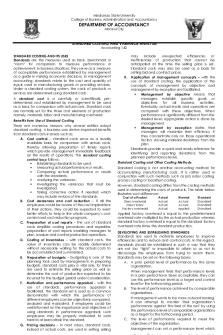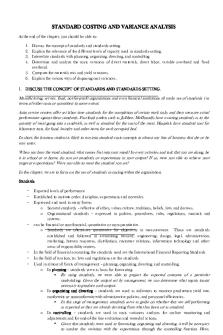Purposes and Advantages of Standard Costing System-Standard Costing and Variance Analysis Formulas PDF

| Title | Purposes and Advantages of Standard Costing System-Standard Costing and Variance Analysis Formulas |
|---|---|
| Course | accounting |
| Institution | Western Mindanao State University |
| Pages | 6 |
| File Size | 103.9 KB |
| File Type | |
| Total Downloads | 79 |
| Total Views | 172 |
Summary
Purposes and Advantages of Standard Costing System-Standard Costing and Variance Analysis Formulas...
Description
Purposes and Advantages of Standard Costing System: Standard costing systems help in planning operations and gaining insights into the probable impact of managerial decisions on cost levels and profits. Standard costs are used for: Establishing budgets. Controlling costs and motivation and measuring efficiencies. Promoting possible cost reduction. Simplifying costing procedures and expediting cost reports. Assigning costs to materials, work in process, and finished goods inventories. Forming the basis for establishing bids and contracts and for setting sales prices. The effectiveness of controlling costs depends greatly upon a knowledge of expected costs. Standards serve as measurements which call attention to cost variations. Executives and supervisors become cost conscious as they become aware of results. This cost consciousness tends to reduce costs and encourages economies in all phases of the business The use of standard costing for accounting purposes simplifies costing procedures through the reduction of clerical labor and expenses. A complete standard cost system is usually accompanied by standardization of productive operations. Standard production or manufacturing orders, calling for standard quantities of product and specific labor operations, can be prepared in advance of actual production. Materials requisitions, labor time tickets, and operation cards can be prepared in advance of production, and standard costs can be compiled. As orders for a part of placed in the shop, previously established requirements, processes, and costs will apply. The more standardized the production, the simpler the clerical effort. Reports can be systematized to present complete information regarding standards, actual costs, and variances. A complete standard cost file by parts and operations simplifies assigning costs to materials, work in process, and finished goods inventories. The use of standard costs stabilizes the influence of materials costs, placing bids, securing contracts, and establishing sales prices are greatly enhanced by the availability of reliable standards and the continuous review of standard costs. The standard cost system may be used in connection with either the process or job order cost accumulation method. However, it is more often used in process
costing because because of the greater practicality of setting standards for a continuous flow of like units than for unique job orders.
Management by Exception and Variance Analysis:
Variance analysis and performance reports are important elements of management by exception. Simply put, management by exception means that the manager's attention should be directed toward those parts of the organization where plans are not working out for reason or another. Time and effort should not be wasted focusing on those parts of the organization where things are going smoothly.
The budgets and standards explained in this section of the web site (See standard costing and Variance Analysis) reflect management's plans. If all goes according to plans, there will be little difference between actual results and the results that would be expected according to the budgets and standards. If this happens, managers can concentrate on other issues.
However, if actual results do not conform to the budget and to standards, the performance reporting system sends a signal to the management that an "exception" has occurred. This signal is in the form of a variance from the budget or standards.
Advantages, Disadvantages and Limitations of Standard Costing System
Advantages / Benefits of Standard Costing System: Standard costing System has the following main advantages or benefits:
The use of standard costs is a key element in a management by exception approach. If costs remain within the standards, Managers can focus on other issues. When costs fall significantly outside the standards, managers are alerted that there may be problems requiring attention. This approach helps managers focus on important issues.
Standards that are viewed as reasonable by employees can promote economy and efficiency. They provide benchmarks that individuals can use to judge their own performance.
Standard costs can greatly simplify bookkeeping. Instead of recording actual co0sts for each job, the standard costs for materials, labor, and overhead can be charged to jobs.
Standard costs fit naturally in an integrated system of responsibility accounting. The standards establish what costs should be, who should be responsible for them, and what actual costs are under control.
Disadvantages / Problems / Limitations of Standard Costing System: The use of standard costs can present a number of potential problems or disadvantages. Most of these problems result from improper use of standard costs and the management by exception principle or from using standard costs in situations in which they are not appropriate.
Standard cost variance reports are usually prepared on a monthly basis and often are released days or even weeks after the end of the month. As a consequence, the information in the reports may be so stale that it is almost useless. Timely, frequent reports that are approximately correct are better than infrequent reports that are very precise but out of date by the time they are released. Some companies are now reporting variances and other key operating data daily or even more frequently.
If managers are insensitive and use variance reports as a club, morale may suffer. Employees should receive positive reinforcement for work well done. Management by exception, by its nature, tends to focus on the negative. If variances are used as a club, subordinates may be tempted to cover up unfavorable variances or take actions that are not in the best interest of the company to make sure the variances are favorable. For example, workers may put on a crash effort to increase output at the end of the month to avoid an unfavorable labor efficiency variance. In the rush to produce output quality may suffer.
Labor quantity standards and efficiency variances make two important assumptions. First, they assume that the production process is labor-paced; if labor works faster, output will go up. However, output in many companies is no longer determined by hw fast labor works; rather, it is determined by the processing speed of machines. Second, the computations assume that labor is a variable cost. However, direct labor may be essentially fixed, then an undue emphasis on labor efficiency variances creates pressure to build excess work in process and finished goods inventories.
In some cases, a "favorable" variance can be as bad or worse than an "unfavorable" variance. For example, McDonald's has a standard for the amount of hamburger meat that should be in a Big Mac. A "favorable" variance would mean that less meat was used than standard specifies. The result is a substandard Big Mac and possibly a dissatisfied customer.
There may be a tendency with standard cost reporting systems to emphasize meeting the standards to the exclusion of other important objectives such as maintaining and improving quality, on-time delivery, and customer satisfaction. This tendency can be reduced by using supplemental performance measures that focus on these other objectives.
Just meeting standards may not be sufficient; continual improvement may be necessary to survive in the current competitive environment. For this reason, some companies focus on the trends in the standard cost variances - aiming for continual improvement rather than just meeting the standards. In other companies, engineered standards are being replaced either by a rolling average of actual costs, which is expected to decline, or by very challenging target costs.
In sum, managers should exercise considerable care in their use of a standard cost system. It is particularly important that managers go out of their way to focus on the positive, rather than just on the negative, and to be aware of possible unintended consequences. Nevertheless standard costs are still found in the vast majority of manufacturing companies and in many service companies, although their use is changing. For evaluating performance, standard cost variances may be supplanted in the future by a particularly interesting development known as the balanced scorecard.
Standard Costing and Variance Analysis Formulas: This is a collection of variance formulas/equations which can help you calculate variances for direct materials, direct labor, and factory overhead.
Direct materials variances formulas Direct labor variances formulas Factory overhead variances formulas
Direct Materials Variances:
Materials purchase price variance Formula: Materials purchase price variance = (Actual quantity purchased × Actual price) – (Actual quantity purchased × Standard price)
Materials price usage variance formula: Materials price usage variance = (Actual quantity used × Actual price) – (Actual quantity used × Standard price)
Materials quantity/usage variance formula: Materials price usage variance = (Actual quantity used × Standard price) – (Standard quantity allowed × Standard price)
Materials mix variance formula: (Actual quantities at individual standard materials costs) – (Actual quantities at weighted average of standard materials costs)
Materials yield variance formula: (Actual quantities at weighted average of standard materials costs) – (Actual output quantity at standard materials cost)
Direct Labor Variances:
Direct labor rate/price variance formula: (Actual hours worked × Actual rate) – (Actual hours worked × Standard rate)
Direct labor efficiency/usage/quantity formula: (Actual hours worked × Standard rate) – (Standard hours allowed × Standard rate)
Direct labor yield variance formula: (Standard hours allowed for expected output × Standard labor rate) – (Standard hours allowed for actual output × Standard labor rate)
Factory Overhead Variances:
Factory overhead controllable variance formula:
(Actual factory overhead) – (Budgeted allowance based on standard hours allowed*)
Factory overhead volume variance: (Budgeted allowance based on standard hours allowed*) – (Factory overhead applied or charged to production**)
Factory overhead spending variance: (Actual factory overhead) – (Budgeted allowance based on actual hours worked***)
Factory overhead idle capacity variance formula: (Budgeted allowance based on actual hours worked***) – (Actual hours worked × Standard overhead rate)
Factory overhead efficiency variance formula: (Actual hours worked × Standard overhead rate) – (Standard hours allowed for expected output × Standard overhead rate)
Variable overhead efficiency variance formula: (Actual hours worked × Standard variable overhead rate) – (Standard hours allowed × Standard variable overhead rate)
Variable overhead efficiency variance formula: (Actual hours worked × Fixed overhead rate) – (Standard hours allowed × Fixed overhead rate)
Factory overhead yield variance formula: (Standard hours allowed for expected output × Standard overhead rate) – (Standard hours allowed for actual output × Standard overhead rate)...
Similar Free PDFs

Objectives of Standard Costing
- 5 Pages
Popular Institutions
- Tinajero National High School - Annex
- Politeknik Caltex Riau
- Yokohama City University
- SGT University
- University of Al-Qadisiyah
- Divine Word College of Vigan
- Techniek College Rotterdam
- Universidade de Santiago
- Universiti Teknologi MARA Cawangan Johor Kampus Pasir Gudang
- Poltekkes Kemenkes Yogyakarta
- Baguio City National High School
- Colegio san marcos
- preparatoria uno
- Centro de Bachillerato Tecnológico Industrial y de Servicios No. 107
- Dalian Maritime University
- Quang Trung Secondary School
- Colegio Tecnológico en Informática
- Corporación Regional de Educación Superior
- Grupo CEDVA
- Dar Al Uloom University
- Centro de Estudios Preuniversitarios de la Universidad Nacional de Ingeniería
- 上智大学
- Aakash International School, Nuna Majara
- San Felipe Neri Catholic School
- Kang Chiao International School - New Taipei City
- Misamis Occidental National High School
- Institución Educativa Escuela Normal Juan Ladrilleros
- Kolehiyo ng Pantukan
- Batanes State College
- Instituto Continental
- Sekolah Menengah Kejuruan Kesehatan Kaltara (Tarakan)
- Colegio de La Inmaculada Concepcion - Cebu














